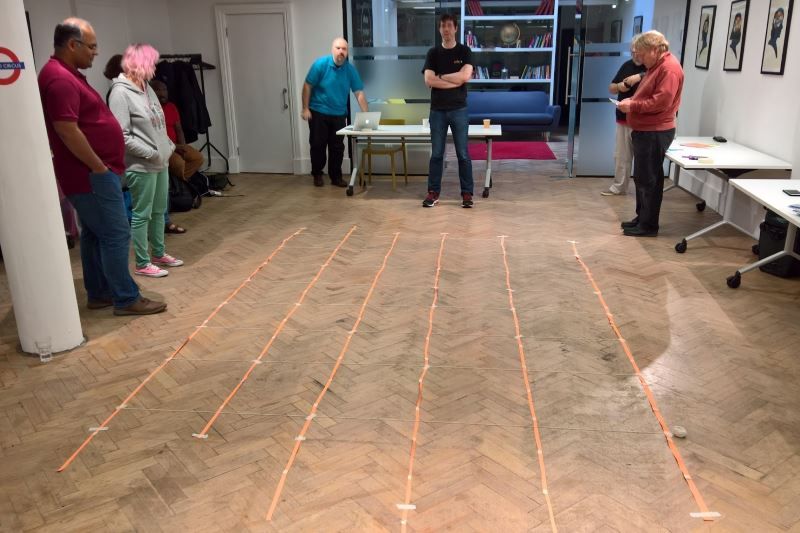HOW TO PLAY
SETUP
Space: You will need a large, empty space to play.
Maze Plan:
- Draw a grid that is 5 squares, by (team's size - 2). E.G. for a team of 9, that would be a 5x7 grid.
- Plot a path by numbering consecutive connected squares from one end of the grid to another. This is an example grid for a team of 9-12 people. Note how it snakes forwards and backwards to increase complexity.

Recreate the grid on the floor with masking tape (squares only). Make each square about 50cm by 50 cm (big enough for a person to stand in).
Position a chair at the finishing end of the labyrinth for the facilitator to stand on.
RULES
The team will have time before starting to solve the labyrinth to collaborate and produce a strategy.
- When the team begin to solve the labyrinth, no further talking is allowed.
- The team may not use any tools or implements to solve the maze (E.G. no breadcrumbs).
- While the labyrinth is being solved, only one team member may enter at a time.
- When a team member steps on an incorrect square, they must return to the beginning by FOLLOWING THE PATH that they have discovered so far. Should they go wrong, they must stop and try again to retrace their steps to the beginning.
- When a team member exits the grid at the beginning (following stepping on an incorrect square) they are not allowed to be the next person to enter grid.
- When a team member successfully completes the labyrinth, everyone from the team has to go through one at a time.
GOAL
The game is won when EVERY team member completes the hidden path.
FACILITATION
- Position the team at the start end of the grid.
- Read out the rules of the game.
- Give the team 10 minutes to discuss and collaborate on a plan to solve the labyrinth.
- When this time up, remind the team that game will now be played in silence.
- Stand on a chair at the finishing end of the grid, facing the grid and the team.
- Tell the team they may begin to solve it.
- When a team member steps on a correct square, state: “CONTINUE”.
- When a team member steps on an incorrect square, state: “STOP, GO BACK”.
- When a team member is going back and steps on an incorrect square, state: “STOP, GO BACK”.
- When a team member attempts to enter the grid two times in a row state: “STOP, GO BACK”.
FACILITATION - MULTIPLE TEAM VARIANTS
Break the group into even teams of 8-15 people.
You will need several copies of the same grid plan. The grid size must work for the smallest team.
You will need one “Grid Master” (additional facilitator) per grid.
The game will play out the same as above, other than:
- Everyone will begin at the same time
- The time needed for the discussion before solving is now flexible, they team can choose to start when they are ready. (This is now a race competition, so there’s an interesting pressure to begin)
- Record the times of each team.
- When a team has completed, invite them to watch how other teams are doing.
REFLECTION
What was your strategy and how did you create it?
How did it feed when you were told to stop and to go back?
What was it like working in silence?
What was it like to be in the labyrinth?
How supported did you feel from the team?
What did it feel like to complete the labyrinth?
MAKING THE GAME EASIER
A team of adults should be able to complete this game, but if you feel the need to make it easier, you can try:
- Simplify the path
- Reduce the grid size
- Allow talking
VIDEOS
Luxembourg 2015
London 2016

